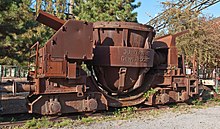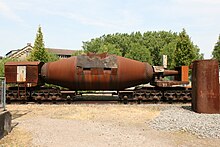Ladle trolley

A ladle wagon is a special railway wagon designed for the transport of molten pig iron . The name pan is derived from the container in which the pig iron from the blast furnace was originally collected, cf. Ladle . This was a flat bowl so that the tap hole of the blast furnace didn't have to be placed unnecessarily high.
Today's blast furnaces, on the other hand, have a lower floor through which rail trains can run. During the tapping process, the pig iron runs into the ladle wagons provided, which today are more in the shape of pots or cigars (so-called torpedo wagons , see next section).
The still liquid pig iron is transported into the wagon for further processing in the foundry ( gray cast iron ) or to the converter (see steel production ).
So that the 1,400 ° C hot metal does not cool down too much during transport and the trolleys are not damaged, the inside of the pans are double-walled with firebricks . The pot-shaped ladle trolleys are covered with a lid.
When driving outside the factory premises, empty flat wagons are often inserted between the ladle wagons as spacers in the train composition in order to avoid excessive load on bridges. Bridges are to be avoided as far as possible or made sufficiently strong on the factory premises.
Torpedo cars
The torpedo wagon (also called torpedo ladle wagon or pig iron mixer wagon ) is a ladle wagon whose ladle (the pig iron mixer ) has a shape reminiscent of a torpedo : an elongated container with a round cross-section between two bogies . This pig iron mixer can be turned by means of a drive installed in the steelworks, which engages in the mechanics of the stationary carriage, in order to empty it. There are also torpedo cars with their own rotator.
Apart from the container itself, the cars have no frame between the bogies so that the container can be made as large as possible. Due to their oversized vehicle gauge, torpedo wagons can only be used on track sections within the steelworks.
A typical torpedo car holds between 160 and 320 tons of molten iron; a train consists of four to six such cars.
Torpedo wagons can be locked tightly and can keep the iron liquid much longer (up to 30 hours) than normal ladle wagons.
Web links
- Martin Radtke: Liquid iron on the move. In: cargo. The logistics magazine from SBB Cargo. 2/2005, ZDB -ID 2178786-4 , pp. 10–12, (report on torpedo cars at SBB), online (PDF; 2.27 MB) , accessed on April 29, 2018.


